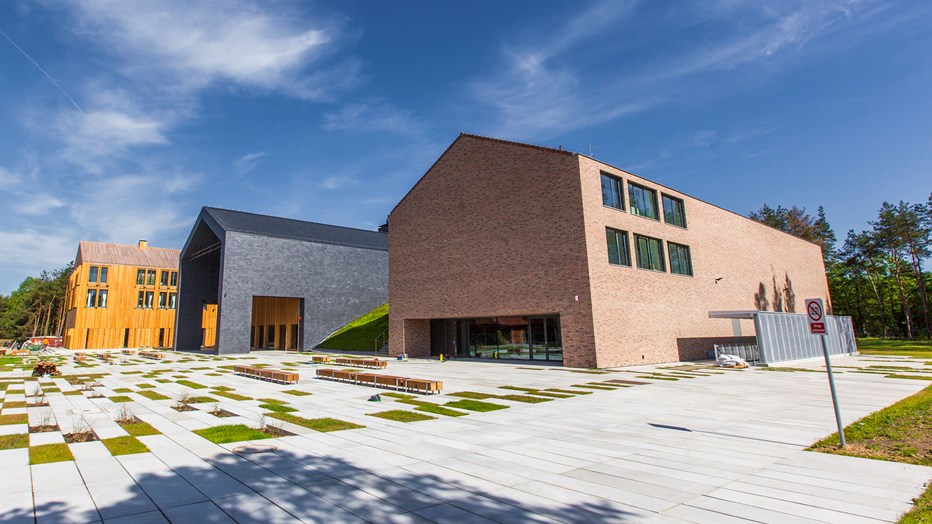Water, fire and sacrum are the elements constituting the compositional framework of the Culture and Recreation Center that was built by Skanska within the premises of the Museum of the Mazovian Countryside in Sierpc.
The newly built complex consists of five parts. Three of them dominate, adopting the look of old rural barns. The connections between the buildings – hidden under green slopes – in combination with retained and new flora, put the complex in the environment of the forest and museum.
Water, fire and sacrum – project composition
The buildings erected by Skanska have been constructed so as to refer to such factors as fire, water and the sacrum, which have always been present in the world of people living in close contact with nature and therefore also in folk culture and art.
The main building is located around two fireplaces — two sites clearly associated with fire. Inside the building, there is a main hall with a restaurant that serves as a traffic junction for particular functional zones in the complex, as well as for the hotel, swimming pool and recreational section (the “water” building) and the performance hall (the “sacrum” building). Upstairs, two multipurpose rooms have been created and in the basement, a recreation zone with a bowling alley and gym. Two fireplaces located in the central part of the building are a symbol of homely warmth and hospitality.
The “water” building is located on the west side of the main building. In the “water” zone there are located features associated with this element, i.e. a complex of swimming pools, saunas and rooms that can accommodate around 150 guests. Having in mind the building’s guests, wellness elements have also been included.
The whole complex is completed by the building corresponding with the need of feeling sacred. It is a great performance hall with an auditorium and a 5.2 x 9.4 m glass wall, which has a view of the forest outside, giving natural scenery for music events. On the first and second floors of the building, there are offices, lighting and sound control rooms, and additionally cabins for interpreters.
The entire facility has been adapted for the needs of people with disabilities.
Original architecture and exceptional atmosphere
Each of the three dominant buildings has been finished off by Skanska with different material, both on the outside (facade and roofing) and on the inside (wall finishes). A clear division of architecture is reflected in the functional layout of the entire building.
The “sacrum building has been finished off almost entirely with hand-molded brick. The “fire” building on the other hand, is easily recognized by the use of slate. It stands out from the other buildings with its glazed front facade walls, giving the building a feel of incredible space. The last building – the “water” building – including a hotel and restaurant, has been finished off with wood.
Within the scope of the contract, Skanska also built a square in front of the building, which connects the newly-built complex with the existing museum buildings and creates a forum which is synonymous with a farmyard and village square around which people’s lives used to concentrate. The courtyard will integrate space, life and outdoor events in this part of the museum.
The scope of work carried out by the company also included land development by building the necessary infrastructure (roads, parking space for cars and buses), greenery planting and small architecture. Furthermore, Skanska equipped the complex and obtained the occupancy permit for it.
Challenges on site
The biggest challenge that Skanska had to face during the execution of this interesting investment was creating five types of facade: hand-molded brick, natural slate, wood, precast concrete and a glass facade on a wooden structure. The construction of tall (over 10 m high) interior walls finished off with the aforementioned slate and hand-molded brick also required vast experience on the part of Skanska.
Oversized dimensions of aluminum fixtures, wooden and glass doors, expanded functionality of the complex and hence, differentiated project solutions (finishing of walls, ceilings and floors) were other challenges Skanska met.
Conferences, training courses and outdoor events
The construction of the Culture and Recreation Center helped in strengthening the position of Sierpc as an important tourist destination, not only in the Masovia region but also at a national scale. The Center is a perfect place for conferences and training courses, as well as outdoor events on a larger scale than before.
The project was made in a consortium by Consultor Sp. z o.o. (arch. Joanna Kapturczak, arch. Michał Kapturczak) and the studio AHOR (arch. Anita Baker).


















